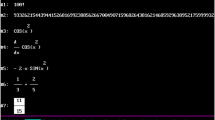Abstract
The constraints of a computer algebra system (CAS) generally induce limitations on its usage. Via the pedagogical features implemented in such a system, “motivating constraints” can appear, encouraging advanced theoretical learning, providing a broader mathematical knowledge and more profound mathematical understanding. We discuss this issue, together with two examples from Calculus, which show an important feature of an instrumentation process.
Similar content being viewed by others
References
Artigue, M. (2002). Learning mathematics in a CAS environment: The genesis of a reflection about instrumentation and the dialectics between technical and conceptual work. International Journal of Computers for Mathematical Learning, 7(3), 245–274.
Balacheff, N. (1994). La transposition informatique: Note sur un nouveau problème sur la didactique. In M. Artigue et al. (Eds.), Vingt ans de didactique en France (pp. 364–370). Grenoble: La Pensée Sauvage.
Böhm, J., Rich, A., & Dana-Picard, T. (2005). About stepwise simplification. Derive Newsletter, 57, 36–38.
Bosch, M., & Chevallard, Y. (1999). La sensibilité de l’activité mathématique aux ostensifs. Objet d’étude et problématique. Recherche en Didactique des Mathématiques, 19(1), 77–124.
Dana-Picard, T. (2004). Explicit closed forms for parametric integrals. International Journal of Mathematical Education in Science and Technology, 35(3), 456–467.
Dana-Picard, T. (2005a). Technology as a bypass for a lack of theoretical knowledge. International Journal of Technology in Mathematics Education, 11(3), 101–110.
Dana-Picard, T. (2005b). Parametric integrals and symmetries of functions. Mathematics and Computers Education, Winter 2005, 5–12.
Garry, T. (2003). Computing, conjecturing, and confirming with a CAS tool. In J. Fey et al. (Eds.), Computer algebra systems in secondary school mathematics education. Reston, VA: NCTM, pp. 137–150.
Guin, D., & Trouche, T. (1999). The complex process of converting tools into mathematical instruments: The case of calculators. International Journal of Computers for Mathematical Learning, 3, 195–227.
Herget, W., Heugl, H., Kutzler, B., & Lehmann, E. (2000). Indispensable manual calculation skills in a CAS environment. http://b.kutzler.com/article/art_indi/art_indi.pdf. Accessed 27 June 2006.
Lagrange, J. B. (1999). Techniques and concepts in pre-calculus using CAS: A two year classroom experiment with the TI-92. International Journal of Computer Algebra in Mathematics Education, 6(2), 43–65.
Lagrange, J. B. (2000). L'intégration d'instruments informatiques dans l'enseignement: Une approche par les techniques. Educational Studies in Mathematics, 43, 1–30.
Meyer, J., & Dana-Picard, T. (1997). Problem solving in mathematics and physics. Proceedings of the 2nd Conference on Teacher Education, Mofet Institute, Tel-Aviv.
Noss, R., & Hoyles, C. (1996). Windows on mathematical meaning. Dordrecht: Kluwer
Pierce, R. (2001). Algebraic insight for an intelligent partnership with CAS. Proceedings of the 12th ICMI Conference, Melbourne, Australia, 732–739.
Sloane, N. J. A. (2006). The on-line encyclopedia of integer sequences. http://www.research.att.com/cgi-bin/access.cgi/as/njas. Accessed 27 June 2006.
Steiner, J., & Dana-Picard, T. (2004). Teaching mathematical integration: Human computational skills versus computer algebra. International Journal of Mathematical Education in Science and Technology, 35(2), 249–258.
Trouche, L. (2000). La parabole du gaucher et de la casserole à bec verseur: étude des processus d'apprentissages dans un environnement de calculatrices symboliques, Educational Studies in Mathematics, 41(2000), 239–264.
Trouche, L. (2004a). Environnements informatisés et Mathématiques: Quels usages pour quels apprentissages? Educational Studies in Mathematics, 55(2004), 181–197.
Trouche, L. (2004b). Managing the complexity of human/machine interactions in computerized learning environments: Guiding students' command process through instrumental orchestrations. International Journal of Computers for Mathematical Learning, 9, 281–307.
Author information
Authors and Affiliations
Corresponding author
Rights and permissions
About this article
Cite this article
Dana-Picard, T. Motivating Constraints of a Pedagogy-Embedded Computer Algebra System. Int J Sci Math Educ 5, 217–235 (2007). https://doi.org/10.1007/s10763-006-9052-9
Received:
Accepted:
Published:
Issue Date:
DOI: https://doi.org/10.1007/s10763-006-9052-9




